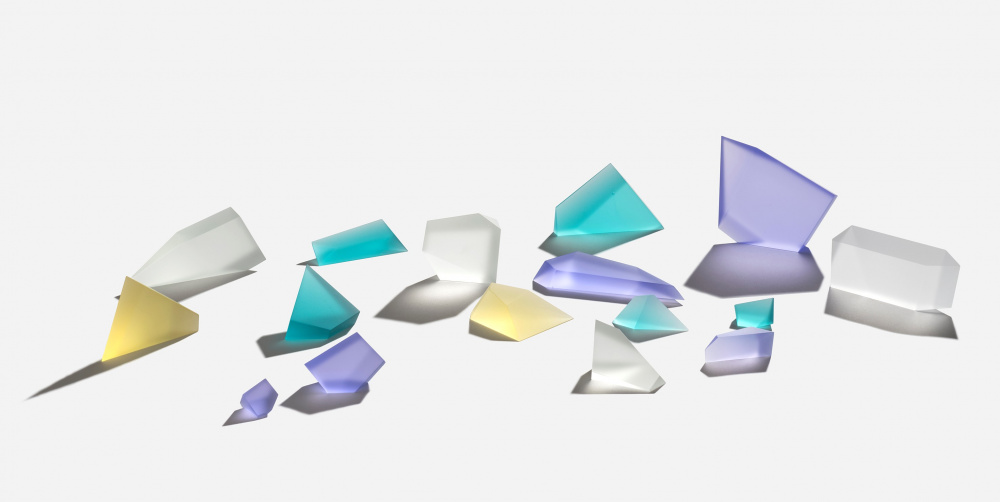
Posted by SASTA
on 18/08/2022
SASTA challenges the science behind the art form of glass making by asking Madisyn Zabel about her experiences.
Madisyn is a Canberra-based artist working with Glass and other mediums to create exciting pieces. We've asked Madisyn a few questions to help us get an idea about how Art meets Science in this year's National Science Week School Theme of Glass. We hope you can use this as a SHE-task tool or even to introduce a new activity into your class.
What experiences shaped your love of glass as an art medium?
Early in my practice, I was fascinated with illusion and perception. Glass has the incredible ability to appear two and three-dimensional through its refractive and reflective properties. During my undergraduate studies at ANU, I began creating geometric works that created similar illusionistic effects to Louis Albert Necker's bistable illusion, the Necker Cube. The Necker Cube challenges the perception of the viewer. The illusion creates a dual focus point, meaning it is impossible to tell which face of the cube is in front and which is behind.
I am still inspired by this illusion and continue to make my own bistable illusions in my current practice through a variety of glass techniques and mixed media.
I love working with glass because of its versatile and transparent nature, and I find that these qualities are great tools for me to explore themes of illusion and perception.
Is it a difficult medium to work with?
Glass can be challenging and frustrating to work with due to its fragility.
There is more science and maths when making glass than you would first think. When making work in a kiln, glass needs to be weighed and measured, time and temperatures all need to be considered.
It can also be challenging to work with when upscaling; the weight of the glass can be physically taxing on your body and tricky to maneuver.
How long does it take to create a piece?
It depends on the process that I use to create a piece - there are many different techniques in glass, including: kilnforming (the process of shaping glass in a kiln with heat and gravity); coldworking (shaping glass with water and abrasives); neon (heating and bending glass which are then pumped with inert gas, these are excited with electricity to produce light); and, casting (heating glass in a kiln until it is at a molten state and allowing it to flow into a mould).
As I use a combination of these techniques, the making time can vary. Some pieces can take days, and others, like my Perceptual Reversal works can take months.

How often has your creation ‘failed’ (I’m trying to demonstrate the need for resilience in science and experimenting!)
I have had many failures in glass, with many pieces breaking in the process, especially during coldworking. This can be as small a setback as a chip or far worse like a whole work being dropped. Small chips can be fixed by grinding a new facet into the piece or grinding out the chips. Sometimes, depending on how big the original work was I can repurpose the broken pieces for other works. If a piece is unsalvageable, I try to learn from the mistake in some way, and try to adapt my practice to avoid the same error again in any future work.
What was your greatest failure (resilience is key in science!)?
One of my most significant failures occurred when I was making my pieces in my Perceptual Reversal series. The works combined large metal frames and cast glass, with the largest piece weighing over 40 kilograms. During the casting process, the kiln malfunctioned, and the temperature exceeded 1000 degrees celsius... The temperature I was aiming for was 850 degrees celsius. Normally with casting you would take the temperature up slowly and hold at the top temperature for a few hours. The slowness of the casting process prevents stress on the mould and on the glass. Since the kiln exceeded the normal casting temperature range and heated the glass too quickly, veils and swirls appeared in the piece. I usually aim for my glass to be as transparent and as pristine as possible to ensure the illusionistic properties of the glass are retained.
In that same casting, as the kiln temperature got too hot too quickly the mould (a mixure of plaster and silica) cracked. The glass was able to seep through the crack and leak out of the mould.
As an artist, do you appreciate the science of glass? If so, to what extent (ie you need to know specific melting temperatures, colour addititves, ratios…it involves maths and physics…)
Without knowing the science behind glass making, it can be difficult to create any artwork. With glass many accidents can occur, which can be dangerous and costly. As glass is quite expensive, it is essential to understand the process to get the desired results without wasting too many resources (material, power and my own energy). Of course, sometimes, I want to experiment and try something new. To do this, I create small tests using my knowledge of the material and tweaking the processes slightly. I ensure to document each step thoroughly in case I want to explore the process further in the future.

What science you to regularly use in your glass creating?
When creating cast glass work, I use compatible glasses that are produced by the same company and follow tried and tested heating and cooling schedules. It is never a good idea to try mixing glasses made in different factories as they usually have different coefficient of expansions meaning (COE) that their melting and cooling points and are incompatible with one another. When melting together incompatible glasses, it can cause stress in a piece. Stress in glass can result in cracks and breakages that don't show up immediately. They and can occur years down the track or when you begin coldworking the piece which can be highly dangerous.
Madisyn's page can be found here. SASTA is grateful to Madisyn for sharing her images with us.
A PDF of this interview can be downloaded here.
In this Section
Archive
- January 2026
- December 2025
- November 2025
- October 2025
- September 2025
- August 2025
- July 2025
- June 2025
- May 2025
- April 2025
- March 2025
- February 2025
- January 2025
- December 2024
- November 2024
- October 2024
- September 2024
- August 2024
- July 2024
- June 2024
- May 2024
- April 2024
- March 2024
- February 2024
- December 2023
- November 2023
- October 2023
- September 2023
- July 2023
- June 2023
- May 2023
- April 2023
- March 2023
- February 2023
- January 2023
- December 2022
- November 2022
- October 2022
- August 2022
- July 2022
- June 2022
- May 2022
- April 2022
- March 2022
- February 2022
- January 2022
- December 2021
- November 2021
- October 2021
- September 2021
- August 2021
- July 2021
- June 2021
- May 2021
- April 2021
- March 2021
- February 2021
- January 2021
- December 2020
- November 2020
- October 2020
- September 2020
- August 2020
- July 2020
- June 2020
- May 2020
- April 2020
- October 2018
- September 2018
- August 2018
- July 2018

